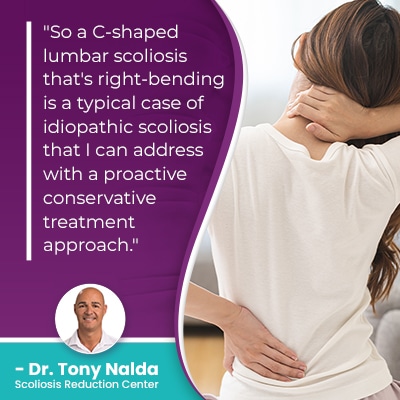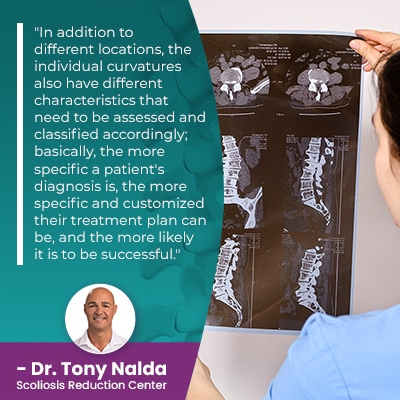Lumbar Scoliosis: Diagnosis & Treatment Of C-Shaped Curves

No two cases of scoliosis are the same, which is why the customization of potentially effective treatment plans is so important. Not only does scoliosis range so widely in severity, there are also multiple conditions and curvature types. Continue reading to understand what a diagnosis of C-shaped lumbar scoliosis means.
A diagnosis of C-shaped scoliosis means the spine has developed an unnatural sideways curve with rotation, and because it's C-shaped, it's a single unnatural curve, as opposed to an S-curve scoliosis that involves two unnatural spinal curves, making it more complex to treat.
Scoliosis can develop anywhere along the spine, so let's start by exploring the different spinal sections and their function.
Table of Contents
The Main Sections of the Spine
There are three main spinal sections: the cervical spine (neck), thoracic spine (middle/upper back), and the lumbar spine (lower back).
Scoliosis can develop anywhere along the spine and can develop in one section or involve two sections as a combined scoliosis.
When it comes to the health of each spinal section's curve, as one long structure, each curve's health is dependant on the health of the others.
Scoliosis is most common in the thoracic spine because this is the largest spinal section, and thoracolumbar scoliosis is a common combined scoliosis that develops in the lower thoracic spine and the upper lumbar spine.
In most spinal conditions, scoliosis included, the area of the body located the closest to the affected spinal section is going to feel the majority of the condition's direct effects; cervical scoliosis is mainly going to affect the upper body, shoulders, neck and head, while thoracic scoliosis can be felt in the mid and upper body, and the effects of lumbar scoliosis are mainly felt in the lower body.
When scoliosis is diagnosed, it means an unnatural sideways curvature of the spine, that also rotates, has developed, and in addition, the unnatural curvature of the spine has to be of a minimum size to be considered a true scoliosis: Cobb angle measurement of at least 10 degrees.
Part of diagnosing scoliosis involves comprehensive assessment so conditions can be further classified based on key patient/condition variables, so let's touch on those, and where a C-shaped lumbar scoliosis would fit.
Diagnosing and Classifying Scoliosis
If the parameters that have to be met to reach a diagnosis of scoliosis have been met, it's time to further specify the diagnosis because this helps streamline the treatment process, and more importantly, informs the crafting of effective treatment plans.
Scoliosis is classified based on patient age, condition type, severity, and location.
Patient Age
 Patient age is important not only because it indicates a person's overall level of health, but because as a progressive condition, scoliosis has it in its nature to get worse over time, and the trigger for progression is growth.
Patient age is important not only because it indicates a person's overall level of health, but because as a progressive condition, scoliosis has it in its nature to get worse over time, and the trigger for progression is growth.
So scoliosis diagnosed in adults is not going to be as at risk for rapid-phase progression as adolescents because the progressive trigger of growth has been removed.
Another reason patient age is important is because scoliosis doesn't become compressive until skeletal maturity has been reached, so in adult scoliosis, pain management is often a focus because it's compression of the spine and its surrounding muscles and nerves that causes the majority of condition-related pain.
So in adults, we know close monitoring for progression is not going to need to be such a focus of treatment, while pain relief will be.
Condition Type
Condition type is determined by causation, and the majority of scoliosis cases, approximately 80 percent, are classified as idiopathic scoliosis diagnosed without understanding what triggers its onset; the remaining 20 percent are associated with known causes: neuromuscular scoliosis, degenerative scoliosis, and congenital scoliosis.
Idiopathic scoliosis is the most common type of scoliosis to affect both children and adults, and adolescent idiopathic scoliosis is the most prevalent type of scoliosis overall.
Neuromuscular scoliosis is caused by the presence of a larger neuromuscular condition like cerebral palsy, muscular dystrophy, or spina bifida, so the underlying neuromuscular condition has to be the focus of treatment.
In cases of degenerative scoliosis, natural age-related spinal degeneration is the cause, so treatment has to focus on stabilizing the spine, preserving spinal function, and pain management.
In cases of congenital scoliosis, babies are born with the condition because it's caused by a malformed spine that develops in utero; this type of scoliosis is structural and complex to treat.
Condition Severity
Condition severity is determined by a patient's Cobb angle measurement, and this is taken during X-ray by drawing lines from the tops and bottoms of the curve's most-tilted vertebrae, and the resulting angle is expressed in degrees.
The higher a patient's Cobb angle, the more severe the condition, and the more complex it is to treat, and remember, as a progressive condition, where a scoliosis is at the time of diagnosis is not indicative of where it will stay:
- Mild scoliosis: Cobb angle measurement of between 10 and 25 degrees
- Moderate scoliosis: Cobb angle measurement of between 25 and 40 degrees
- Severe scoliosis: Cobb angle measurement of 40+ degrees
- Very-severe scoliosis: Cobb angle measurement of 80+ degrees
Condition severity is the main factor that determines the path of treatment and also determines the types of symptoms of scoliosis patients are likely to experience.
Curvature Location
 As mentioned, scoliosis can develop anywhere along the spine, in a single section, or in more than one as a combined scoliosis, and this is more common in a double curve, also known as an S-curve scoliosis.
As mentioned, scoliosis can develop anywhere along the spine, in a single section, or in more than one as a combined scoliosis, and this is more common in a double curve, also known as an S-curve scoliosis.
In addition to different locations, the individual curvatures also have different characteristics that need to be assessed and classified accordingly; basically, the more specific a patient's diagnosis is, the more specific and customized their treatment plan can be, and the more likely it is to be successful.
So scoliosis that develops in the neck would be diagnosed as cervical scoliosis; scoliosis in the thoracic spine would be diagnosed as thoracic scoliosis, and lumbar scoliosis refers to scoliosis that's developed in the lower back.
What's a C-Curve Scoliosis?
In typical cases of idiopathic scoliosis, there is a single unnatural spinal curve that bends to the right, away from the heart; in fact, if I see a single C-shaped curve, but it bends to the left, towards the heart, this is a red flag that it's not idiopathic scoliosis and that there is an underlying pathology as in cases of neuromuscular scoliosis, adult degenerative scoliosis, and congenital scoliosis.
So a C-curve scoliosis that's right-bending is a typical case of idiopathic scoliosis and with early intervention can be highly treatable.
In an S-shaped scoliosis, there are two unnatural spinal curves, which complicates the treatment process and involves determining which is the major and minor curve, and concentrating treatment on the larger of the two, initially.
What's a C-Shaped Lumbar Scoliosis?
So a diagnosis of a C-shaped lumbar scoliosis means that a single unnatural sideways spinal curve with rotation has developed in the lower back.
As the lumbar spine has to support the weight of the entire trunk, the spinal sections above, and feels the effects of bending, lifting, and twisting motions, the lower back is vulnerable to the development of a number of spinal conditions/issues, and it's estimated that everyone will experience lower back pain at one point or another in their lives.
So a C-shaped lumbar scoliosis that's right-bending is a typical case of idiopathic scoliosis that I can address with a proactive conservative treatment approach.
Conclusion
A C-shaped lumbar scoliosis means a typical scoliotic curvature of the spine has developed in the lower back, and like all forms of scoliosis, it is progressive, so being proactive with treatment is key to avoiding progression and the need for invasive surgical treatment in the future.
In cases of adolescent idiopathic scoliosis, patients are monitored for rapid-phase progression because being in the stage of puberty, with its rapid and unpredictable growth spurts, the goal of treatment is to achieve a significant curvature reduction and hold it there, counteracting the constant trigger of growth.
When a C-shaped idiopathic lumbar scoliosis is diagnosed in adults, the focus of treating adult idiopathic scoliosis is different; there doesn't have to be such a focus on counteracting progression so treatment can be slower and more gradual, and there needs to be more of a focus on pain management and stabilizing the spine.
While there are never treatment guarantees, early detection and early intervention do increase the likelihood of treatment success, and when treated proactively, spinal surgery can be avoided through the application of proactive conservative non-surgical treatment.
Here at the Scoliosis Reduction Center, my treatment approach combines condition-specific chiropractic care, physical therapy, corrective bracing, and rehabilitation so conditions can be impacted on every level.
Dr. Tony Nalda
DOCTOR OF CHIROPRACTIC
After receiving an undergraduate degree in psychology and his Doctorate of Chiropractic from Life University, Dr. Nalda settled in Celebration, Florida and proceeded to build one of Central Florida’s most successful chiropractic clinics.
His experience with patients suffering from scoliosis, and the confusion and frustration they faced, led him to seek a specialty in scoliosis care. In 2006 he completed his Intensive Care Certification from CLEAR Institute, a leading scoliosis educational and certification center.
About Dr. Tony Nalda
 Ready to explore scoliosis treatment? Contact Us Now
Ready to explore scoliosis treatment? Contact Us Now





